Cassini Mission and Findings
On October 15, 1997, the Cassini orbiter and its attached Huygens probe launched on a seven-year journey to Saturn. The Cassini mission was a collective effort of NASA, the European Space Agency (ESA) and the Italian space agency, Agenzia Spaziale Italiana (ASI).
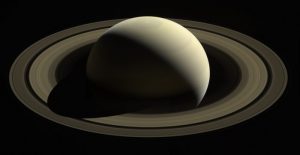
Along the way, the spacecraft collaborated studies of Jupiter for six months in 2000 with Galileo spacecraft studying gas giants. On June 30, 2004, the spacecraft finally reached Saturn. Cassini studied Saturn’s moons and on that same year, ESA’s Huygens probe was released on Saturn’s moon, Titan. On 2005, Huygens made its descent through Titan’s atmosphere to conduct atmosphere and surface composition studies.
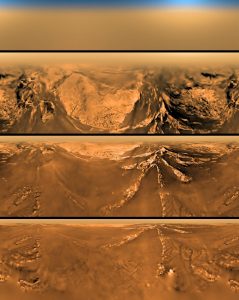
View the complete timeline of the Cassini-Huygens spacecraft.
By 2008 Cassini had completed its primary mission to explore Saturn’s system. Its first mission extension began, called Cassini Equinox Mission and its purpose was to perform several flybys of Saturn’s moons including 26 flybys of Titan.
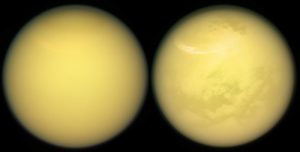
On 2010 Cassini completed its Equinox Mission and began its second extension mission, Cassini Solstice Mission. When Cassini arrived at Saturn the planet’s northern winter solstice had just ended. The second extension allowed Cassini to complete a seasonal period study. Throughout this mission, Cassini made the first complete seasonal observations of Saturn and its moons.
Cassini’s Highlight Findings
1. The Great White Spot
In 2010, thermal images from Cassini’s CIRS instrument captured two very bright and very warm sports. These two merged after a few months and circled the entire planet for around 2 months. these kind of storms are kind or regular on Saturn and occur once every 20-30 years.
2. Pack-Man Moons
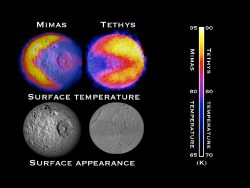
Saturn has 62 moons; most of them are icy satellites. Using the CIRS instrument NASA superimposed thermal maps of these icy moons and found they resembled Pac-Man. The reason for these unique thermal images is the two different icy surfaces of the moons.
The moons have two sides. The back of the moon is called the Trailing side. This side is composed of fluffy snow and thus it heats quickly and acts as an insulator. The front side facing the direction of where the moon moves to is called the Leading side. This icy surface gets packed and compressed which means it heats slowly and thus it shows as cooler on the thermal imaging.
3. Enceladus Temperature
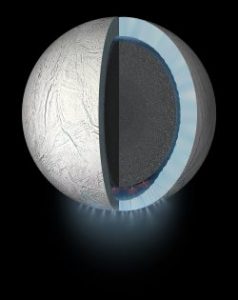
Enceladus is also an icy moon which sub-surface contains liquid water. The CIRS instrument captured Enceladus’ temperature and showed an unpredicted finding -the South Pole was the warmest section of the moon. NASA concluded this was due to Tidal Friction; the moon was heating up because of Saturn’s gravitational pull. As the moon approached Saturn, Enceladus stretched itself horizontally and then returned to its regular shape as it moved away from the planet causing friction within the moon. This heated up the sub-surface water and thus venting it into space through cracks caused by the constant change of the moon’s shape.
4. Titan
Cassini’s spectrometers were able to see through Titan’s hazy environment. Finding revealed lakes, river and dunes on the moon’s surface. Another finding includes the discovery of a previously undetected hydrocarbon molecule in Titan’s atmosphere, Propylene. On Earth Propylene, is used as to create topper ware plastic. The molecule was found in 2013 using CIRS filling in a gap that had puzzled physicists since the Voyager mission, 32 years ago.
5. Saturn’s Rings
Cassini’s helped gain a lot of knowledge about Saturn’s rings. Particles in the rings can be as small as a grain of sand and as big as a mountain. Cassini also discovered that the moon Enceladus provides much of the material in Saturn’s E ring. Saturn’s Equinox also revealed magnified ring features. During Saturn’s equinox, the ring’s edge faces the sun directly. The shadow they castes on Saturn revealed icy clusters that would measure miles.
Now we know a world-size more about Saturn and its moons. Saturn has very active rings and a chaotic atmosphere with storms raging expanding around the planet. Cassini gave us immeasurable knowledge and breath-taking images of Saturn and its moons.
Take a look at all of Cassini’s images here.
Cassini’s Last Status
Resources for Educators:
- https://www.nasa.gov/press-release/cassini-spacecraft-makes-its-final-approach-to-saturn
- https://www.nasa.gov/feature/goddard/2017/excitement-and-tears-as-nasa-goddard-team-prepares-for-cassini-finale
- Cassini timeline missions: https://www.jpl.nasa.gov/missions/cassini-huygens/
- Cassini’s latest mission status: https://saturn.jpl.nasa.gov/mission/grand-finale/latest-status/
